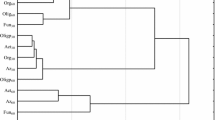Abstract
Humic acids in a concentration of up to 100 μg ml-1 affect the activity of choline esterase of pea only weakly during sinapin (choline ester of sinapic acid) hydrolysis. The inhibition is stronger at higher concentrations. A similar course of inhibition with humic acids was also observed during the synthesis of sinapin catalysed with choline acyltransferase present in the same enzyme extract. The organophosphate malathion is a strong inhibitor of both the hydrolysis and the synthesis of sinapin. Thus, for example, at a 3.5 × 10-5 M concentration it causes 85% inhibition of pea choline esterase. However, in combination with 100 μg of humic acids this inhibition decreases to about 8%. It was observed that humic acids prevent the inhibition of both the hydrolysis and the synthesis of sinapin with malathion even at low concentrations. The interaction of the organophosphate malathion with humic acids seems specific. Humic acids do not affect the inhibition of choline esterase with physostigmine or the inhibition of the hydrolysis and the synthesis of sinapin with chlorocholine chloride, alar and hexamine either. This is also true of the activation of the processes with the K+ ions. Humic acids represent competitive inhibitors of choline esterase. Malathion shows an acompetitive — noncompetitive character of the inhibition. The interaction of humic acids with malathion in the roots of the plants may also be assumed in the soil when malathion is applied as an insecticide.
Similar content being viewed by others
References
Austin, F. L., Wolff, I. A.: Sinapin and related esters in seed meal ofCrambe abyssinica. - Agr. Food Chem.16: 132–135, 1968.
Kasturi, R., Vasanthabajan, V. N.: Properties of acetylcholine-esterase fromPisum sativum. -Phytochemistry15: 1345–1347, 1976.
Kutáček, M., Kefeli, V. I., Pospíš≫, F., de Almeida Rita Malini, Vacková, K., Eder, J., Michaïlovskiï, N.: [Complex hydroxycinnamic acid derivatives ofBrassicaceae plants and the contribution of cholinesterase to their metabolism.] in Russ. - In:Kefeli, V. I. (ed.): Rost Rasteniï i Prirodnye Regulyatory. In press. Nauka, Moskva 1979.
Pospíšil, F., Hrubcová, M.: The effects of humic acids and their fractions on the phytase activity. - Věd. Práce YÚRV (Praha)18: 47–54, 1974.
Pospíšil, F., Hrubcová, M.: The influence of humic acids on phytase activity isolated from wheat seeds. - Biol. Plant.17: 468–474, 1975.
Pospíšil, F., Zelená, E.: The role of humic acids in reducing the toxicity of the organophosphate malathion and the influence of humic acids on the root- and plant cell growth. - Abstr. Symp. Humus et Planta VII. Brno 1979.
Riov, J., Jaffe, M. I.: Cholinesterases from plant tissues. 1. Purification and characterization of cholinesterase from mung bean roots. - Plant Physiol.51: 520–528, 1973.
Segel, I. H.: Enzyme Kinetics. Behavior and Analysis of Rapid Equilibrium and Steady-State Enzyme Systems, - John Wiley, New York-London 1975.
Author information
Authors and Affiliations
Rights and permissions
About this article
Cite this article
de Almeida, R.M., Pospíšil, F., Vacková, K. et al. Effect of humic acids on the inhibition of pea choline esterase and choline acyltransferase with malathion. Biol Plant 22, 167–175 (1980). https://doi.org/10.1007/BF02892734
Received:
Accepted:
Issue Date:
DOI: https://doi.org/10.1007/BF02892734




